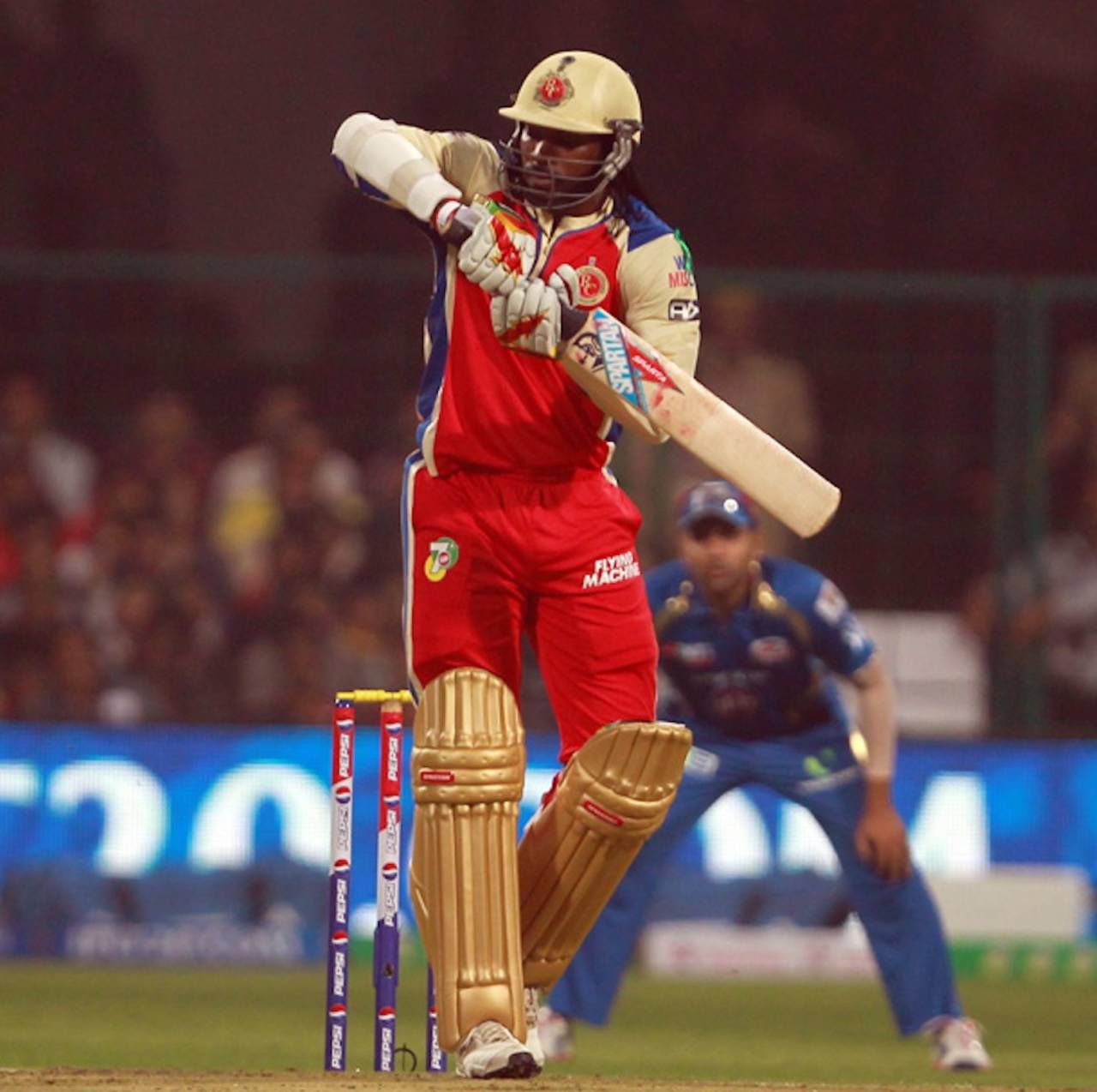Gayle forces the pace of change
Clad in his space-garb, his gold pads and his gridiron helmet, shoulders rippling under his muscle shirt, Chris Gayle is an implacable object, driving cricket forwards, challenging the world to produce another batsman that plays like him
Jon Hotten
08-Apr-2013

Chris Gayle bestrides T20 like "a conceptual force" • BCCI
Chris Gayle has presented an almost completely realised vision of the future of Twenty20 batsmanship. On Sunday he offered another shimmering insight into what is to come during the Super Over finish between Royal Challengers Bangalore and Hyderabad Sunrisers. Chasing 20 and facing a flat-out, pumped-up Dale Steyn, Gayle was required to hit the last two balls of the game for six. He dispatched the first before knocking the second disconsolately to long-off, foxed by Steyn's shorter length. The point was not that Gayle had failed, but rather that no one would have been surprised if he had succeeded. At the crease, he trails a new sense of the possible behind him. If not Twenty20's Bradman, then he is its WG, its Ranji. In its infant years, he is a conceptual force.
One in every nine deliveries that Gayle has faced in T20 cricket has been hit for six, and it is a ratio that is rising towards one in eight. Around that glowing headline stat, he has constructed a method of batting which has produced an unmatched consistency through its counter-intuitive lack of risk. With it, he is separating himself from the rest.
By the blunt tool of average, his mark of 44.51 is way beyond those who can reproduce his strike rate of 154.72, while those who can come within range of that average cannot approach his speed: Kieron Pollard strikes at 160.33, but averages 29; Virender Sehwag 156.24 but averages 27, David Warner at 142.59 but averages 31. Sachin Tendulkar averages 35.69 but strikes at 121; Shaun Marsh 42.24 but strikes at 131.46, Kevin Pietersen 34.41 but strikes at 137.10. Or consider this: Gayle has ten T20 centuries, which is more than Tendulkar, AB de Villiers, Pietersen, Sehwag, Jacques Kallis, Virat Kohli, Shane Watson and Warner combined.
Other batsman can do what Chris Gayle does. What is unique about Gayle is that he does it so often. His last 12 innings in the IPL have been 87, 4, 86, 71, 26, 82 not out, 57, 6, 128 not out, 27, 92 not out and 1. For the last two editions of the competition, he has made the most runs at the highest average, and his 51.27 overall is the record. Only five players have made more runs that Gayle's 1,988; none average more than 33, none approach his strike rate, all have played at least 20 games more than he has.
More significant is the way that Gayle does what he does. During his 92 not out against Mumbai last week, he made 4 from his first 12 deliveries, and 10 from his first 17. His strike rate did not exceed 100 until he had faced 21 deliveries. His 128 not out from 62 against Delhi last year was similar. He didn't score from his first eight deliveries, and by the end of the first powerplay had 10 from 17. In his 57 from 31 against Pune, he had four from his first eight deliveries and 17 from his first 16. In his 82 from 59 against Mumbai in the match before that, he had two from his first ten and 22 from his first 19; in his 71 from 42 against Kings XI, it was 21 from his first 19; in his 86 from 58 against KKR he had 23 from his first 25.
Gayle is deliberately enigmatic, he rarely gives interviews. He sees no benefit in demystifying himself, and in a way he is right, because it is adding to his legend
The other half of the equation is that the acceleration, when it comes, is unprecedented. A strike rate for the second stage of his innings would be revelatory, because Gayle's strategy is not just to hit boundaries but to clear the ropes. He has hit 354 sixes in T20 cricket, 109 more than the next best, Pollard. There is method to that striking. A loose study of his boundary counts shows that he tends to hit fours in his first 20 or so deliveries and then moves on to sixes.
Conversely, counterintuitively, such carnage reduces risk. Gayle can afford to block out dangerous deliveries not just early in his innings, but whenever they come. He doesn't even need to take singles from them because the team benefits from him being on strike. Gayle's ability to hit actually makes him safer, because he hits on his terms.
Early dismissal is the only flaw in his method. When that happens, as it did during his only really poor run of recent years in the Big Bash of 2012-13, he has eaten up a section of the first Powerplay without return.
It would be fascinating to hear Gayle talk about all of this, but he is deliberately enigmatic. He rarely gives interviews and when he does they tend to yield the wrong kind of headlines. He sees no benefit in demystifying himself, and in a way he is right, because it is adding to his legend.
Clad in his space-garb, his gold pads and his gridiron helmet, shoulders rippling under his muscle shirt, he is an implacable object, driving the game forwards, challenging the world to produce another batsman that plays as he does. That would demand a swaggering confidence but his arrival is inevitable, because Gayle has hit on a method of playing that sets him apart. As hard as it might be to imagine what T20 cricket will look like in two decades, it's equally hard not to think it that will look a lot like Chris Gayle.